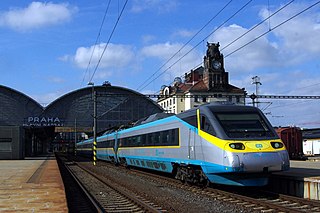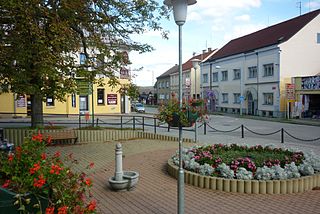
Transport in the Czech Republic relies on several main modes, including transport by road, rail, water and air.
České dráhy, often shortened to ČD, is the major railway operator in the Czech Republic providing regional and long-distance services.

České Velenice is a town in Jindřichův Hradec District in the South Bohemian Region of the Czech Republic. It has about 3,700 inhabitants. It lies on the border with Austria and is adjacent to the town of Gmünd, to which it once belonged.

Lužná is a municipality and village in Rakovník District in the Central Bohemian Region of the Czech Republic. It has about 2,000 inhabitants.

Czechoslovak State Railways was the state-owned railway company of Czechoslovakia.

Izera railway is a line connecting the Polish town of Jelenia Góra (Hirschberg) with Szklarska Poręba (Schreiberhau). It is part of the former Prussian Zackenbahn, that used to connect Prussia with the Austro-Hungarian Empire via the New World Pass. The line is currently operated by PKP as line number 311.

Rail transport in Slovakia began on September 21, 1840, with the opening of the first horse-powered line from Bratislava to Svätý Jur. The first steam-powered line, from Bratislava to Vienna, opened on August 20, 1848.

Meziměstí is a town in Náchod District in the Hradec Králové Region of the Czech Republic. It has about 2,300 inhabitants.

Zákolany is a municipality and village in Kladno District in the Central Bohemian Region of the Czech Republic. It has about 600 inhabitants.

Horní Blatná is a town in Karlovy Vary District in the Karlovy Vary Region of the Czech Republic. It has about 400 inhabitants. The town is historically associated with tin mining and is located in the Ore Mountain Mining Region, which is a UNESCO World Heritage Site. The historic town centre is well preserved and is protected by law as an urban monument zone.

Class E 499.1 electric locomotives were constructed and built by Škoda Works in Plzeň for use in Czechoslovakia by the ČSD. They were also used outside Czechoslovakia in Poland as class EP05 and in the Soviet Union as ЧС3 (ChS3). In North Korea, licence built copies were used.

ČSD Class E 499.3 electric locomotives were used primarily for passenger trains in Czechoslovakia. Locomotives which passed to České dráhy, rail operator in the Czech Republic are now classified as Class 163, those which passed to ZSSK, rail operator in Slovakia, are also Class 163.

The Děčín–Dresden railway, also called the Elbe Valley Railway is an electrified main line in Saxony and the Czech Republic. Formerly called the Saxon-Bohemian State Railway, the line is part of the Dresden to Prague route and is one of Europe's most important trunk routes (Magistralen). It runs along the Elbe Valley from Děčín via Bad Schandau and Pirna to Dresden. The first section of the line was opened in 1848 and is one of the oldest lines in Germany.

Josefův Důl is a municipality and village in Jablonec nad Nisou District in the Liberec Region of the Czech Republic. It has about 900 inhabitants.

RegioJet a.s. is a private Czech provider of passenger rail and bus transport. The company Student Agency, owned by Czech businessman Radim Jančura, is the sole owner. A sister company of the same name, with its registered office in Bratislava, is an operator of passenger rail and bus transport in Slovakia.

Rail transport in the Czech Republic carried 193.5 million passengers in 2019, and 68.37 million tonnes of cargo in the year 2009. The majority of passenger services run nowadays are operated by the state company České dráhy, which until 2007 also managed cargo services now run by ČD Cargo. In 2009 the country had 9,420 km of standard gauge track, 3,153 km of which is electrified. There are two main electrification systems in the Czech Republic, 3 kV DC in the northern part, and 25 kV 50 Hz AC in the south. Locomotives had to be changed on boundaries in the past, two-system locomotives have been introduced in 1974. The network has same gauge links to all four countries bordering the Czech Republic with passenger services to all four countries in operation. Major hubs for international passenger services on the network are in Prague, Ostrava, Brno and Břeclav, and the busiest station is Praha hlavní nádraží. The maximum speed for passenger traffic is 160 km/h (100 mph).

ČD Cargo, a.s. is a state-owned Czech railway operator focused on freight operations. It is a wholly-owned subsidiary of the passenger railway operator České dráhy.

High-speed rail in the Czech Republic is being planned with construction starting in 2026 and maximum speed between 200 and 320 km/h. Although České Dráhy owns and operates multiple rolling stock capable of speeds of 230 km/h (143 mph) since 2004, there is, as of 2023, no infrastructure capable of velocity over 200 km/h (124 mph). The only exception is the 13.3-kilometre long track at Velim railway test circuit with a maximum allowed speed of 230 km/h (143 mph) for tilting trains and up to 210 km/h (130 mph) for conventional trains. Czech rolling stock manufacturer Škoda Transportation has produced high-speed rolling stock since the 1970s.

Cheb railway station is a railway station in the city of Cheb in the Karlovy Vary Region in the western part of the Czech Republic.

Liberec railway station is a railway station in the city of Liberec, the capital of the Liberec Region, Czech Republic.



















